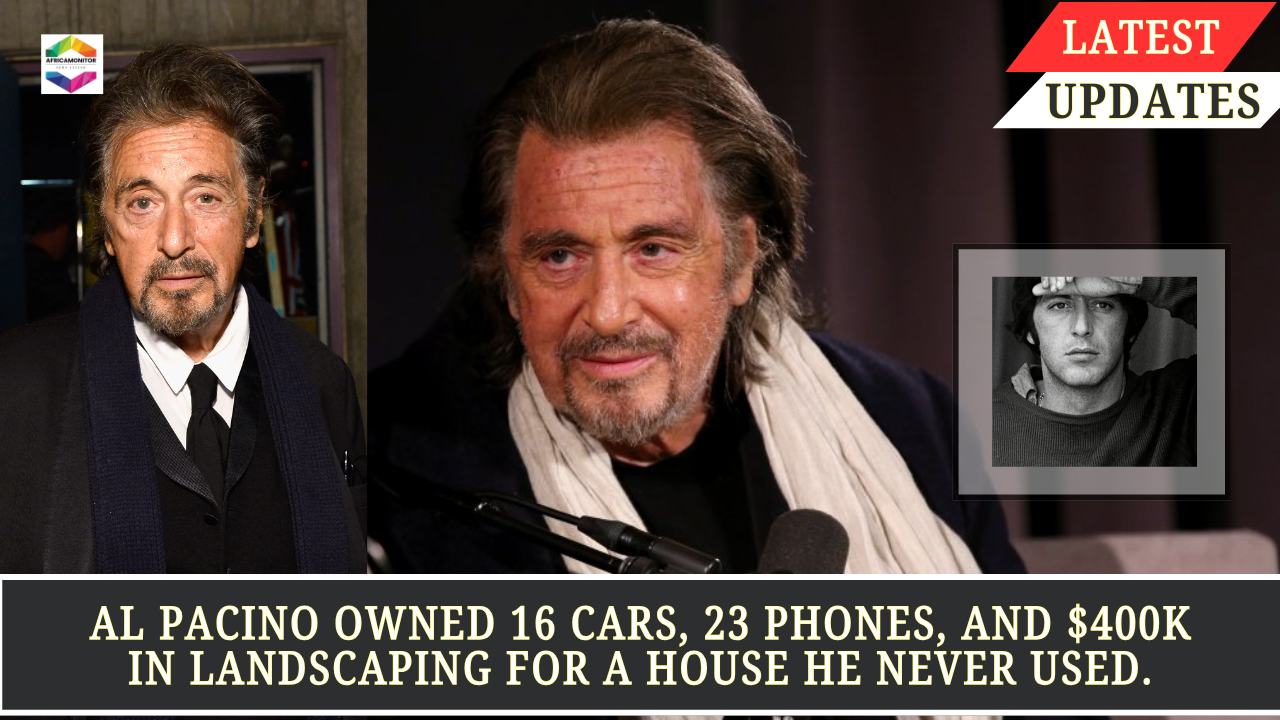Introduction
More than half a century ago, Al Pacino was involved with some of Hollywood’s most iconic films. Ranging from “The Godfather,” “Scarface,” “Scent of a Woman,” and more, honours, critical acclamation, and fan love poured for Pacino, yet fame was not the financial security rainbow, as, despite being in tens of millions, the actor in millions went bankrupt. From blowing money like there’s no tomorrow for 16 autos and 23 mobile phones to spending $400,000 on landscaping for a mansion that he would never set foot in, from which he would never advance, the spending habits of Pacino clearly showed Hollywood excess and danger of financial irresponsibility.
The Golden Years of Success
I know that mentioning the financial issues of Pacino would be very meaningless unless mentioning his rise to fame. Al Pacino, born in 1940, is a case of growing up in the Bronx. From his early theatrical career when it is obvious how much he loved acting, he acted Michael Corleone in “The Godfather.” in 1972, which changed his life for good. It led him to Hollywood superstar fame and wining money.
Pacino became a star in the 1970s and 1980s. His performances-from Tony Montana in “Scarface” to his Oscar-winning “Scent of a Woman”-were iconic. His paycheck reflected his Hollywood stardom. He earned millions for every movie by the turn of the millennium with a net worth accumulated over decades of excellence. Like most stars today, Pacino, also was financially mismanaged despite his superstardom.
Read More: Sofia Richie Discusses Pregnancy Issues: ‘Terrified’ Welcome Daughter

Financial Mismanagement Takes Hold
His acting was marvelous, but money management wasn’t. His lifestyle did change with fame. By the 1990s, Pacino lived in mansions that were highly lavish, drove expensive automobiles, and enjoyed high-cost lifestyles. But his financial decisions got out of hand.
His automobile obsession was a classic case of spending for no reason. Pacino owned 16 luxury cars which included some rare and exotics. He never used most of them; they stayed in the garage or driveway. These cost a lot to keep running and insure. Spending on status symbols did not enhance his life or work.
Pacino was peculiar for having many mobile phones and being a car enthusiast. At one time, the actor had 23 cell phones with various features. This was too much for contacting agencies, handling personal life, and communicating with friends. All those extra phones and time lost in handling all those were unnecessary.
Costly House and Grounds
One of the biggest monetary blunders Pacino made was in spending on properties he rarely used. There were many places he owned homes, but one became a financial crisis. The premium real estate property had enormous lawns, gardens, and outdoor areas that required upkeep. Pacino reportedly spent almost $400,000 beautifying this mansion.
This is even more shocking because Pacino hardly ever stayed in the residence. Though the actor preferred other places for his residency, it became a status symbol. Still, property maintenance expenses increased. The cost for landscaping, taxes, utilities, and house maintenance was draining his savings account. This outrageous spending on a residence he never used stands as a classic example of his financial irresponsibility that led him to crash.
Throughout his career, Pacino took a number of questionable gambles with the stamp of most stars that strike overnight fame. For example, Pacino invested himself in businesses through advisors and financial managers that promised returns that were far too good to be true but instead lost. A lot of money was thrown down the drain on failed business connections that never materialized and unrealized businesses.
Trusting people who did not care for him was one of the worst financial moves he ever made. Poor investments and solicitations for money exhausted his treasuries. Such trades worsened his financial situation, although the nature of those trades is not known.

Living Hollywood Style
The Hollywood lifestyle is expensive. Pacino attended expensive shows, dined in expensive restaurants, and wore luxurious clothes to maintain himself as a high-ranking actor. End.
He used to carry thousands of dollars in luxury suits. His lifestyle of parties and travel and entourage has added more burden on his wallet. Since he was earning big money from his acting assignments, the lavish lifestyle of the actor kept the money flowing out fast as it came in.
Legal and financial liabilities
Lawsuit and significant debts were not enough for Pacino’s lists of financial troubles. He had massive legal fees arising from litigations, settlement agreements, and contracts. These fees, along with his lavish spendings, made him vulnerable financially.
He had to pay child support and alimony claims, which were big money indeed. Some of the long-term relationships that Pacino had brought upon financial commitments only worsened his financial condition.
The Road to Recovery
Apart from his financial crisis, it can easily be noticed that Pacino’s acting career survived. He starred in other movies like “The Irishman” and “House of Gucci.” Even though he had not recovered fully, these work stabilized his financial level.
In the past several years, Pacino spent much less money. Many mansions have been sold, and his rich lifestyle has been declined; instead of prominence, his work is already emphasized. Even though he may never get back into the high levels of success financially, the example given by Pacino proves the need for even the most successful to handle one’s money well.
8. Lessons Learned from Al Pacino’s Financial Troubles
Al Pacino’s story offers several important lessons for those in any profession, but particularly for those who find themselves in the spotlight:
- Financial Education Is Key: No matter how much money one makes, understanding how to manage it is crucial. Without proper financial education, even the wealthiest individuals can find themselves in trouble.
- Beware of Excess: Pacino’s love for cars, cell phones, and lavish properties shows that excess spending can lead to financial ruin. It’s important to live within one’s means, even when wealth seems endless.
- Trust the Right People: Many of Pacino’s financial troubles were the result of trusting the wrong advisors. It’s essential to have a reliable, trustworthy team in place when managing large sums of money.
- Invest Wisely: Bad investments can quickly drain a fortune. Whether it’s business ventures, real estate, or other financial opportunities, it’s crucial to do thorough research and consult with experts before making big financial decisions.
- Long-Term Planning: The Hollywood lifestyle often emphasizes living in the moment, but long-term financial planning is vital. Planning for the future, including retirement and unforeseen expenses, can help avoid financial pitfalls.
Read More: Travis Kelce Stars in ‘Are You Smarter Than a Celebrity?’: A Guide to the New Game Show
Conclusion
Al Pacino’s fall from Hollywood royalty to financial ruin reminds one that celebrity and money do not automatically provide stability. He was on the verge of bankruptcy because of his lavish spending on cars, mansions, and other personal frivolities; he even made some relatively bad investments. To add to it, he received some lousy financial advice.
Still, acting resilience and the ability to keep working kept Pacino afloat. His tale serves as a cautionary measure to the new rich that the richest of the world can lose everything without proper financial management.
FAQs
1. Al Pacino’s bankruptcy: why?
Over-spending on cars, cell phones, and other vacant homes
2. How many cars did he owned?
He had 16 cars
3. He spent $400K on his landscaping.
What for? For his vacant house.
4. How many cellphones did he have?
23 cellphones.
5. Did it impact his acting career?
It hurt his purse but not his career.

